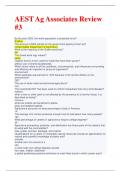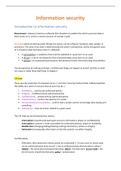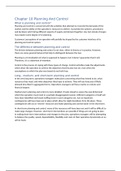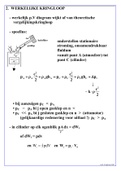A note on the importance of
measurement
Accounting = a set of rules determining recognition, measurement and display that defines mapping
a company’s financial position into its financial statements.
Recognition: when do we recognize something?
Measurement= how do we measure something to put it in the balance sheet?
Display: how should the financial statements look like? (loose form)
INCOME-BASED APPROACH
Make the balance sheet based on the income statement
Starts from transactions that took place
Relies on historical costs, accrual accounting and matching
Advantages:
o Intuitively meaningful
o Element of reliability because of the observable transactions
Disadvantage:
o Values of assets and equity are valued at historical cost (may be outdated)
BALANCE SHEET-BASED APPROACH
Make the income statement based on the balance sheet
Relies on current values of assets and liabilities
o What will the assets and liabilities will cost/generate in the future?
o Value of A & L = discounted value of expected future cash flows
Determine current values through either market prices or estimates
o Clean surplus income = ALL value changes in A & L are included in the income state
calculation
Income = ∆value assets - ∆value liabilities
Disadvantage: huge impact on the calculation of ratios
Increases volatility decreases share price
o >< Dirty surplus accounting = value changes are directly booked in A & L, not via
income statement
Advantage: less volatility, better for the companies (lobby)
HC FV
Profit Equity
HC FV HC FV
Year 1 16,67 42,97 116,67 142,97
Year 2 19,17 7,15 138,48 150,12
Year 3 21,79 7,51 157,63 157,63
Sum 57,63 57,63
,RESIDUAL INCOME VALUATION
Important to take into account that money that you put in equity of a company, can not be
used to invest somewhere else.
, Chapter 1: the IASB and its
conceptual framework
IFRS are set by the IASB (International Accounting Standard Board)
Funded by contributions from major accounting firms, private financial institutions and
industrial companies, central and development banks, etc.
They began to realize the importance of having common standards in all areas of the
financial reporting chain
ADVANTAGES OF IFRS
Easier comparison
Worldwide the same standard in case of subsidiaries
Easier to raise capital abroad
Higher quality of accounting but audit is still necessary
IFRS IN EUROPE: ALL LISTED COMPANIES HAVE TO
APPLY IFRS
European Financial Reporting Advisory Group (EFRAG)
o Ensures that European views are taken into account when developing new standards
o Provides advice to the European Commission about the standards
Endorsement process
o IASB adopts new standard, an amendment or a new interpretation
o EFRAG provides advice to the European Commission
o European Commission decides weather or not to endorse, drafts a regulation and
submits this to the ARC (Accounting Regulatory Committee)
o If ARC agrees, draft is sent to European Parliament and Council for 3 months scrutiny
period
o If everything is ok, the commission adopts the endorsing regulation
IFRS IN THE US
Securities and Exchange Commission (SEC)
Financial Accounting Standards Board (FASB)
Convergence plan between IASB and FASB
DIFFERENCES BETWEEN IFRS AND US GAAP
IFRS does not permit LIFO
US GAAP requires development cost to be expensed when the incur (no capitalization)
US GAAP does not allow for revaluations of tangible and intangible assets
THE PURPOSE OF THE CONCEPTUAL FRAMEWORK
To assist in developing a consistent set of standards & dealing with topics not covered by a
standard
o To assist preparers of financial statements
o To assist auditors in forming an opinion
o To assist users in the interpretation of information
, When a user is in doubt, go back to the framework to find guidance
QUALITATIVE CHARACTERISTICS OF USEFUL
INFORMATION
Fundamental qualitative characteristics
o Relevance (have the ability to influence a decision)
o Faithful representation
Enhancing qualitative characteristics
o Comparability
o Verifiability
o Timeliness
o Understandability
ASSUMPTIONS UNDERLYING FINANCIAL STATEMENTS
Financial statements are prepares under the going concern assumption
o Allocation of depreciation over useful life
o Support inclusion of goodwill in statement of financial position
o Otherwise IFRS 5 (discontinues operations)
DEFINITION, RECOGNITION AND MEASUREMENT OF
ELEMENTS IN FINANCIAL STATEMENTS
Definition Recognition
Assets Future economic benefits Probable
Entity must have control Reliable
There must be a past event
Liabilities A present obligation Probable
Must result in giving up resources Reliable
Results from past transaction
Equity Assets – Liabilities Probable
Reliable
Influenced by the measurement system
adopted (accounting system)
Income Increase in economic benefits (also A&L) Probable
Reliable
Expenses Decrease in economic benefits (also A&L) Probable
Reliable
Measurement involves assigning valuations on all elements reported in financial statements
Measurement basis (no obligation, just overview of possibilities
o Historical cost
o Current cost
measurement
Accounting = a set of rules determining recognition, measurement and display that defines mapping
a company’s financial position into its financial statements.
Recognition: when do we recognize something?
Measurement= how do we measure something to put it in the balance sheet?
Display: how should the financial statements look like? (loose form)
INCOME-BASED APPROACH
Make the balance sheet based on the income statement
Starts from transactions that took place
Relies on historical costs, accrual accounting and matching
Advantages:
o Intuitively meaningful
o Element of reliability because of the observable transactions
Disadvantage:
o Values of assets and equity are valued at historical cost (may be outdated)
BALANCE SHEET-BASED APPROACH
Make the income statement based on the balance sheet
Relies on current values of assets and liabilities
o What will the assets and liabilities will cost/generate in the future?
o Value of A & L = discounted value of expected future cash flows
Determine current values through either market prices or estimates
o Clean surplus income = ALL value changes in A & L are included in the income state
calculation
Income = ∆value assets - ∆value liabilities
Disadvantage: huge impact on the calculation of ratios
Increases volatility decreases share price
o >< Dirty surplus accounting = value changes are directly booked in A & L, not via
income statement
Advantage: less volatility, better for the companies (lobby)
HC FV
Profit Equity
HC FV HC FV
Year 1 16,67 42,97 116,67 142,97
Year 2 19,17 7,15 138,48 150,12
Year 3 21,79 7,51 157,63 157,63
Sum 57,63 57,63
,RESIDUAL INCOME VALUATION
Important to take into account that money that you put in equity of a company, can not be
used to invest somewhere else.
, Chapter 1: the IASB and its
conceptual framework
IFRS are set by the IASB (International Accounting Standard Board)
Funded by contributions from major accounting firms, private financial institutions and
industrial companies, central and development banks, etc.
They began to realize the importance of having common standards in all areas of the
financial reporting chain
ADVANTAGES OF IFRS
Easier comparison
Worldwide the same standard in case of subsidiaries
Easier to raise capital abroad
Higher quality of accounting but audit is still necessary
IFRS IN EUROPE: ALL LISTED COMPANIES HAVE TO
APPLY IFRS
European Financial Reporting Advisory Group (EFRAG)
o Ensures that European views are taken into account when developing new standards
o Provides advice to the European Commission about the standards
Endorsement process
o IASB adopts new standard, an amendment or a new interpretation
o EFRAG provides advice to the European Commission
o European Commission decides weather or not to endorse, drafts a regulation and
submits this to the ARC (Accounting Regulatory Committee)
o If ARC agrees, draft is sent to European Parliament and Council for 3 months scrutiny
period
o If everything is ok, the commission adopts the endorsing regulation
IFRS IN THE US
Securities and Exchange Commission (SEC)
Financial Accounting Standards Board (FASB)
Convergence plan between IASB and FASB
DIFFERENCES BETWEEN IFRS AND US GAAP
IFRS does not permit LIFO
US GAAP requires development cost to be expensed when the incur (no capitalization)
US GAAP does not allow for revaluations of tangible and intangible assets
THE PURPOSE OF THE CONCEPTUAL FRAMEWORK
To assist in developing a consistent set of standards & dealing with topics not covered by a
standard
o To assist preparers of financial statements
o To assist auditors in forming an opinion
o To assist users in the interpretation of information
, When a user is in doubt, go back to the framework to find guidance
QUALITATIVE CHARACTERISTICS OF USEFUL
INFORMATION
Fundamental qualitative characteristics
o Relevance (have the ability to influence a decision)
o Faithful representation
Enhancing qualitative characteristics
o Comparability
o Verifiability
o Timeliness
o Understandability
ASSUMPTIONS UNDERLYING FINANCIAL STATEMENTS
Financial statements are prepares under the going concern assumption
o Allocation of depreciation over useful life
o Support inclusion of goodwill in statement of financial position
o Otherwise IFRS 5 (discontinues operations)
DEFINITION, RECOGNITION AND MEASUREMENT OF
ELEMENTS IN FINANCIAL STATEMENTS
Definition Recognition
Assets Future economic benefits Probable
Entity must have control Reliable
There must be a past event
Liabilities A present obligation Probable
Must result in giving up resources Reliable
Results from past transaction
Equity Assets – Liabilities Probable
Reliable
Influenced by the measurement system
adopted (accounting system)
Income Increase in economic benefits (also A&L) Probable
Reliable
Expenses Decrease in economic benefits (also A&L) Probable
Reliable
Measurement involves assigning valuations on all elements reported in financial statements
Measurement basis (no obligation, just overview of possibilities
o Historical cost
o Current cost









